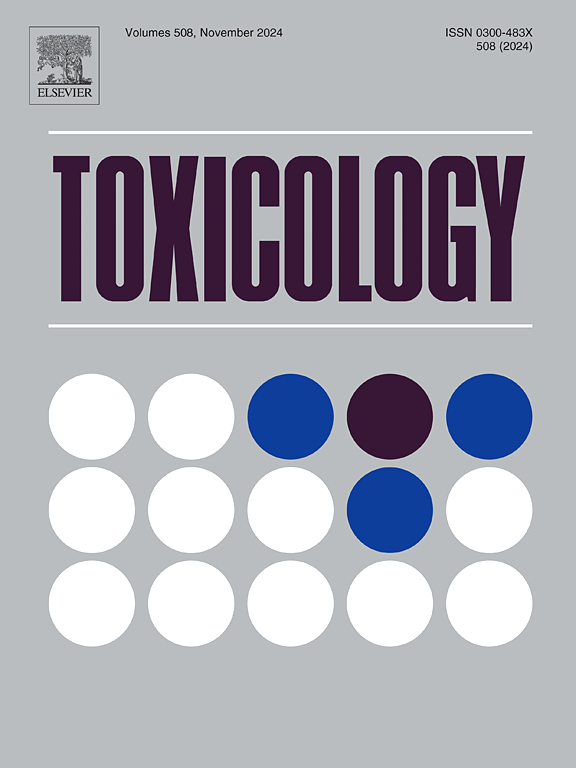应用网络毒理学、分子对接和机器学习策略对枸橼酸乙酰三丁酯甲状腺毒性及机制进行有效分析。
IF 4.8
3区 医学
Q1 PHARMACOLOGY & PHARMACY
引用次数: 0
摘要
日益普遍的环境污染物引起了人们对其在甲状腺功能障碍和相关疾病中的潜在作用的关注。先前的研究表明,各种化学物质,包括增塑剂,如乙酰柠檬酸三丁酯(ATBC),可能会对甲状腺健康产生不利影响,但确切的机制仍然知之甚少。本研究的目的是阐明乙酰柠檬酸三丁酯(ATBC)对甲状腺的复杂作用,并阐明环境污染物影响疾病过程的潜在分子机制。通过对ChEMBL、STITCH和GEO等数据库的详尽研究,我们确定了19个与ATBC和甲状腺密切相关的潜在靶点。在使用STRING平台和Cytoscape软件进行严格筛选后,我们将该列表缩小到15个候选靶点,最终确定了五个核心靶点:CBX5, HADHB, TRIM33, TP53和CUL4A,利用三种成熟的机器学习方法。在DAVID数据库中进行的深度基因本体(GO)和京都基因与基因组百科全书(KEGG)通路分析显示,ATBC影响甲状腺的主要通路涉及关键信号级联,包括FoxO信号通路和脂肪酸代谢等代谢通路。此外,利用molecular Operating Environment软件进行分子对接模拟,证实了ATBC与这些核心靶点之间存在强结合相互作用,增强了我们对它们相互作用的理解。总之,我们的研究结果为理解ATBC对甲状腺损伤影响的复杂分子机制提供了理论框架,并为针对暴露于含ATBC的塑料或过度暴露于ATBC引起的甲状腺疾病的预防和治疗策略的发展铺平了道路。本文章由计算机程序翻译,如有差异,请以英文原文为准。
Effective analysis of thyroid toxicity and mechanisms of acetyltributyl citrate using network toxicology, molecular docking, and machine learning strategies
The growing prevalence of environmental pollutants has raised concerns about their potential role in thyroid dysfunction and related disorders. Previous research suggests that various chemicals, including plasticizers like acetyl tributyl citrate (ATBC), may adversely affect thyroid health, yet the precise mechanisms remain poorly understood. The objective of this study was to elucidate the complex effects of acetyl tributyl citrate (ATBC) on the thyroid gland and to clarify the potential molecular mechanisms by which environmental pollutants influence the disease process. Through an exhaustive exploration of databases such as ChEMBL, STITCH, and GEO, we identified a comprehensive list of 19 potential targets closely associated with ATBC and the thyroid gland. After rigorous screening using the STRING platform and Cytoscape software, we narrowed this list to 15 candidate targets, ultimately identifying five core targets: CBX5, HADHB, TRIM33, TP53, and CUL4A, utilizing three well-established machine learning methods. In-depth Gene Ontology (GO) and Kyoto Encyclopedia of Genes and Genomes (KEGG) pathway analyses conducted in the DAVID database revealed that the primary pathways through which ATBC affects the thyroid gland involve key signaling cascades, including the FoxO signaling pathway and metabolic pathways such as fatty acid metabolism. Furthermore, molecular docking simulations using Molecular Operating Environment software confirmed strong binding interactions between ATBC and these core targets, enhancing our understanding of their interactions. Overall, our findings provide a theoretical framework for comprehending the intricate molecular mechanisms underlying ATBC's effects on thyroid damage and pave the way for the development of preventive and therapeutic strategies against thyroid disorders caused by exposure to ATBC-containing plastics or overexposure to ATBC.
求助全文
通过发布文献求助,成功后即可免费获取论文全文。
去求助
来源期刊

Toxicology
医学-毒理学
CiteScore
7.80
自引率
4.40%
发文量
222
审稿时长
23 days
期刊介绍:
Toxicology is an international, peer-reviewed journal that publishes only the highest quality original scientific research and critical reviews describing hypothesis-based investigations into mechanisms of toxicity associated with exposures to xenobiotic chemicals, particularly as it relates to human health. In this respect "mechanisms" is defined on both the macro (e.g. physiological, biological, kinetic, species, sex, etc.) and molecular (genomic, transcriptomic, metabolic, etc.) scale. Emphasis is placed on findings that identify novel hazards and that can be extrapolated to exposures and mechanisms that are relevant to estimating human risk. Toxicology also publishes brief communications, personal commentaries and opinion articles, as well as concise expert reviews on contemporary topics. All research and review articles published in Toxicology are subject to rigorous peer review. Authors are asked to contact the Editor-in-Chief prior to submitting review articles or commentaries for consideration for publication in Toxicology.
 求助内容:
求助内容: 应助结果提醒方式:
应助结果提醒方式:


